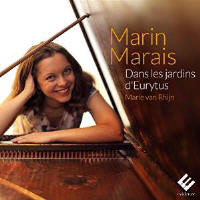Texte paru dans: / Appeared in: |
|
|
"...music
... expertly performed" |
Outil de traduction ~ (Très approximatif) |
|
Reviewer: Barry
Brenesal The works on this album belong to the category of French Baroque music transcribed for the enjoyment of whatever inner circle, or salon, the arranger belonged to. They were harpsichord transcriptions, mostly anonymous but well made, at a time when this was the easiest way to hear an opera no longer in the active repertoire, or recall it when not at the theater. Lully, who so far as we know never wrote a note for the harpsichord, is survived by roughly 220 mostly operatic transcriptions for the instrument. Marais, who wrote four tragédies en musique and hundreds of pieces for viol, ended up with many harpsichord transcriptions of both, if not approaching Lully in sheer number. Most of the arrangements on this release are anonymous, though well executed with attention paid to contrapuntal lines and moments of orchestra-like sonority. One, a sarabande, is known to be a transcription by Jean-Henri d’Anglebert, himself a fine harpischordist and composer who left much in manuscript. A couple are by Marie van Rhijn herself, to round out the music drawn from act V of Alcide, which is otherwise missing. Alcide provides one of the two focal points for the album: an opera composed by Marais with some assistance by Jean-Baptiste Lully’s son, Louis, and premiered in 1693. The rest of the disc is devoted to a suite van Rhijn has devised of harpsichord transcriptions from Marais’s Second Book of Viol Pieces, published in 1701.The composer himself suggested pieces from the latter were suitable for performance on a number of instruments, including the harpsichord, but as this was done by quite a few composers—and publishers, too, without regard to their composer’s wishes—to increase sales, we have no idea if Marais was serious in suggesting such transcriptions would make eminent musical sense, or merely supply him a bit more of a return on what was, after all, some of his life’s finest work. The two sections—26 transcriptions from Alcide, eight viol transcriptions—could not be more different. Alcide shows Marais sensitive to the shifting mood of the opera-going public as Louis XIV under Madame de Maintenon’s influence moved his musical interests more towards religious works. As a result, this tragédie en musique is already part-way to becoming opéra-ballet. Marais’s viol works are for the most part serious, lyrical, fluidly phrased, and elevated in style. They present a marked contrast to Alcide’s many dances and airs, which possess a charm equal to anything similar in Lully’s output, including the dance sequences in Cadmus, Amadis, and Thésée. I have no criticism to offer of Rhijn’s technical competence. She adjusts her ornamentation and phrasing, free or rhythmically bound, to the contrasting styles of these two works. Her counterpoint is always clear. Just occasionally she pushes tempos, so that the poor nymphs in the Air pour les nymphes et les zéphyrs receive a truly thorough aerobic workout. But the Allemande from the Suite in B Minor is taken moderately, while the famous Tombeau pour M. du Lully is given at a rich, slow pace to fully register the piece’s chromatic instability and shifts of harmonic direction. The
instrument used, one of unidentified craftsmanship, is dated 1679, by
coincidence the same year Marais was appointed Ordinaire de la chambre du
Roi pour la viole, a post he held until 1725. It has a deep, full tone in
its bass, though it is a bit thin at the top. No tuning is mentioned, though
judging by the results, quarter-comma meantone is in use. It remains to
mention one other curiosity about this disc: It includes the complete texts
in French and English from Alcide of each of the airs and choruses
transcribed within. That adds a further level of distinction to an album
whose music is a delight, and expertly performed. | |
|
|
|
|
Cliquez l'un ou l'autre
bouton pour découvrir bien d'autres critiques de CD |
|




